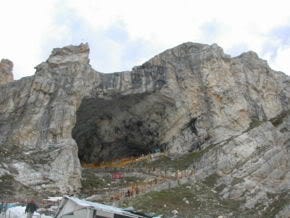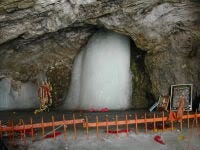Lies and falsehoods on Amarnath
This is from Wikipedia. If you have any other source and evidence that this is not correct, please let me know. But for me, it is not at all surprising that the Kashmiri separatist Muslims and their secular friends in India are creating use-less myths about Amarnath Shrine. It is not important if you do or do not believe in idol worship (whatever the logic of such anti-idol belief and its weakness may be – blind-man painting . idol worship ), what is important is that for someone its a way of life and their faith. There is no reason to paint a bad picture of it. If it had been 1940s and 50s the seculars and the Kashmiri separatist Muslims would have gotten away with it.. but this is the age of blogs.. so there is no way someone can try to put out false-hoods and succeed! So here goes..
************
The separatists in Kashmir and their “secular” supporters are trying to spread the myth that the Amaranth Yatra is of a recent origin.
They claim that it started only after a Muslim shepherd of Batakot, a certain Buta Malik, originally”discovered” the Amarnath cave when he lost his flock and found that it had strayed into the sacred spot some 150 years ago. There is no documentary proof of this so-called discovery, the story having probably been concocted to give credit to Muslims for having started the most popular Hindu pilgrimage of Kashmir.
There is ample and conclusive historical evidence, on the other hand, to prove that the holy cave and the ice lingam were known to the people since very ancient times and have been continuously and regularly visited by pilgrims not only from Kashmir but also from different parts of India. While the earliest reference to Amarnath can be seen in the Nilamata Purana (v.1324), a 6th century Sanskrit text which depicts the religious and cultural life of early Kashmiris and gives Kashmir’s own creation myth, the pilgrimage to the holy cave has been described with full topographical details in the Bhringish Samhita and the Amarnatha Mahatmya, both ancient texts said to have been composed even earlier. References to Amarnath, known have also been made in historical chronicles like the Rajatarangini and its sequels and several Western travellers’ accounts also leaving no doubt about the fact that the holy cave has been known to people for centuries. The original name of the tirtha, as given in the ancient texts, is of course Amareshwara, Amarnath being a name given later to it.
Giving the legend of the Naga Sushruvas, who in his fury burnt to ashes the kingdom of King Nara when he tried to abduct his daughter already married to a Brahmin youth, and after the carnage took his abode in the lake now known as Sheshnag (Kashmiri Sushramnag), Kalahana writes:
“The lake of dazzling whiteness [resembling] a sea of milk (Sheshnag), which he created [for himself as residence] on a far off mountain, is to the present day seen by the people on the pilgrimage to Amareshwara.”(Rajatarangini, Book I v. 267.Translation: M. A. Stein).
This makes it very clear that pilgrims continued to visit the holy Amarnath cave in the 12th century, for Kalhana wrote his chronicle in the years1148-49.
At another place in the Rajatarangini (Book II v. 138), Kalhana says that King Samdhimat Aryaraja (34 BCE-17CE) used to spend “the most delightful Kashmir summer” in worshiping a linga formed of snow “in the regions above the forests”. This too appears to be a reference to the ice linga at Amarnath. There is yet another reference to Amareshwara or Amarnath in the Rajatarangini (Book VII v.183). According to Kalhana, Queen Suryamati, the wife of King Ananta (1028-1063), “granted under her husband’s name agraharas at Amareshwara, and arranged for the consecration of trishulas, banalingas and other [sacred emblems]”.
In his Chronicle of Kashmir, a sequel to Kalhana’s Rajatarangini, Jonaraja relates that that Sultan Zainu’l-abidin (1420-1470) paid a visit to the sacred tirtha of Amarnath while constructing a canal on the left bank of the river Lidder (vv.1232-1234). The canal is now known as Shah Kol.
In the Fourth Chronicle named Rajavalipataka, which was begun by Prjayabhatta and completed by Shuka, there is a clear and detailed reference to the pilgrimage to the sacred site (v.841,vv. 847-849). According to it, in a reply to Akbar’s query about Kashmir Yusuf Khan, the Mughal governor of Kashmir at that time, described among other things the Amarnath Yatra in full detail. His description shows that the not only was the pilgrimage in vogue in Akbar’s time – Akbar annexed Kashmir in 1586 – but the phenomenon of waxing and waning of the ice linga was also well known.
Amareshwar (Amarnath) was a famous pilgrimage place in the time of the Mughal emperor Shah Jahan also. In his eulogy of Shah Jahan’s father-in-law Asif Khan, titled “Asaf Vilas”, the famous Sanskrit scholar and aesthete Panditraj Jagannath makes clear mention of Amareshwara (Amarnath) while describing the Mughal garden Nishat laid out by Asif Khan. The King of gods Indra himself, he says, comes here to pay obeisance to Lord Shiva”.
As we well know Francois Bernier, a French physician accompanied Emperor Aurangzeb during his visit to Kashmir in 1663. In his book “Travels in Mughal Empire” he writes while giving an account the places he visited in Kashmir that he was “pursuing journey to a grotto full of wonderful congelations, two days journey from Sangsafed” when he “received intelligence that my Nawab felt very impatient and uneasy on account of my long absence”. The “grotto” he refers to is obviously the Amarnath cave as the editor of the second edition of the English translation of the book, Vincient A. Smith makes clear in his introduction. He writes: “The grotto full of wonderful congelations is the Amarnath cave, where blocks of ice, stalagmites formed by dripping water from the roof are worshipped by many Hindus who resort here as images of Shiva…..”
Another traveler, Vigne, in his book “Travels in Kashmir, Ladakh and Iskardu” writes about the pilgrimage to the sacred spot in detail, clearly mentioning that “the ceremony at the cave of Amarnath takes place on the 15th of the Hindoo month of Sawan” and that “not only Hindoos of every rank and caste can be seen collecting together and traveling up the valley of Liddar towards the celebrated cave……” Vigne visited Kashmir after his return from Ladakh in 1840-41 and published his book in 1842. His book makes it very clear that the Amarnath Yatra drew pilgrims from the whole of India in his time and was undertaken with great enthusiasm.
Again, the great Sikh Guru Arjan Dev is said to have granted land in Amritsar for the ceremonial departure of Chari, the holy mace of Lord Shiva which marks the beginning of the Yatra to the Holy Cave. In 1819, the year in which the Afghan rule came to an end in Kashmir, Pandit Hardas Tiku “founded the Chhawni Anmarnath at Ram Bagh in Srinagar where the Sadhus from the plains assembled and where he gave them free rations for the journey, both ways from his own private resources”, as the noted Kashmiri naturalist Pandit Samsar Chand Kaul has pointed out in his booklet titled “The Mysterious cave of Amarnath”. Not only this, Amarnath is deeply enshrined in the Kashmiri folklore also as stories like that of Soda Wony clearly show. One can, therefore, conclude without any doubt that the Amaranth Yatra has been going on continuously for centuries along the traditional route of the Lidder valley and not a century and a half affair. May be during the Afghan rule when religious persecution of the Kashmiri Hindus was at its height and they were not allowed to visit their places of worship the pilgrimage was discontinued for about fifty or sixty years and during this period the flock of some shepherd may have strayed into the holy cave, but that in no way makes it of a recent origin or a show window of so-called Kashmiriat.
The temple is reported to be about 5,000 years old[1] and was mentioned in ancient Hindu texts. The exact manner of discovery of the cave is not known.
The Amarnath Yatra, according to Hindu belief, begins on Ashadha Purnima (day of the Full Moon in the Hindu Month of Ashadha) and ends on Shravana Purnima (day of the full moon in the Hindu month of Shravana). The two-month Yatra for the year 2007 began on July 1, 2007 amidst tight security and adverse weather conditions.





